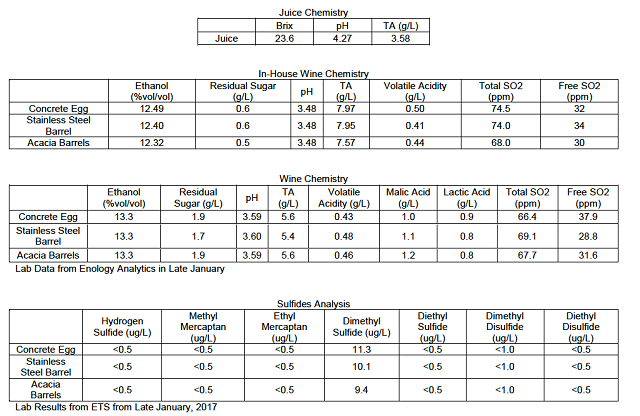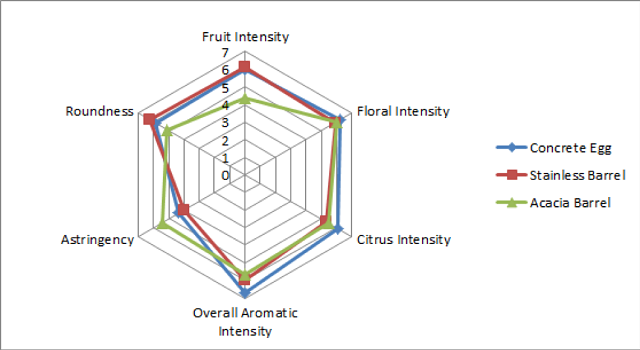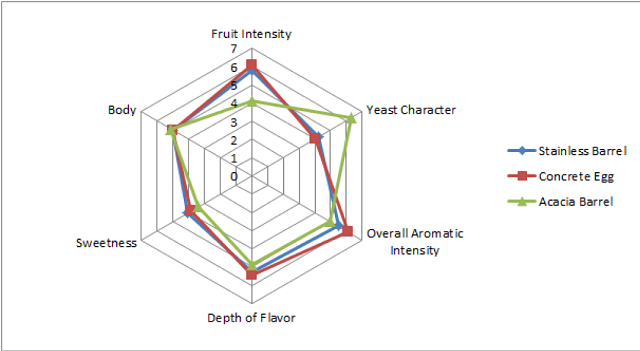The Effect of Different Aging Vessels on the Sensory Qualities of Viognier
Matthew Meyer
Williamsburg Winery
Summary and Introduction
Different aging vessels can have drastic effects on the sensory qualities of wine. Concrete eggs, stainless steel barrels, and acacia barrels are aging vessels that are beginning to come in vogue in many different wineries, each providing different potential benefits and problems. This study examines the effects of aging Viognier wine in concrete eggs, stainless steel barrels, and acacia barrels on the chemical and sensory qualities of Viognier. One lot of Viognier wine was split into these different aging vessels after a week of fermentation. The wine was aged in these vessels for approximately four months. No chemical differences could be found between wines, except that acacia barrels exhibited the lowest levels of dimethyl sulfide. Aging in acacia barrels tended to reduce Fruit Intensity and Overall Aromatic Intensity and increase Yeast Character. Stainless steel and concrete egg aging tended to help maintain Fruit Intensity and Aroma. In general, aging in acacia barrels was least preferred compared to other treatments. More studies on these different aging vessels should be performed, perhaps with different aging times and types of wine.
Results and Discussion
No large chemical differences could be found between wines, except that acacia barrels exhibited the lowest levels of dimethyl sulfide.

For the February 15 tasting, the wines were found to have strong trends with regard to Fruit Intensity, with Acacia barrel-aged Viognier having lower Fruit Intensity than Concrete Egg and Stainless Steel Barrel Aging. Roundness also tended to be slightly higher in Concrete Eggs and Stainless Steel barrels. Acacia barrels had a small tendency to increase Astringency, and concrete eggs slightly increased Citrus Intensity and Overall Aromatic Intensity. In general, people tended to prefer wine aged in the Concrete Egg. The wine in the Acacia barrel was cloudy, and the wines were in general perceived to be acidic.


For the March 15 tasting, there was a strong trend for wine aged in Acacia Barrels to be have less Fruit Intensity and more Yeast Character than the Concrete Egg and Stainless Steel Barrel wines. The wine in Acacia Barrel tended to be lower in Sweetness and Overall Aromatic Intensity as well, but this was a weaker tendency. In general, there was a strong dislike for the wine aged in the Acacia Barrel, and judges had no preference for Concrete Egg over Stainless Steel Barrels.


Methods
Viognier was harvested on 9/13, held overnight in cold storage, and processed on 9/14. Tartaric acid was added to adjust pH and TA during processing and Cinn Free was also added. The juice was cold settled for 3 days and then racked. Exotics yeast was added at 500g/1000 gallons after the juice warmed up slightly, and Go-Ferm and Optiwhite were added as well. DAP and Fermaid K were added during fermentation as well. After fermenting for 1 week in a stainless steel tank, the fermenting juice was racked into the following vessels for aging:
Vessel 1: Concrete Egg
Vessel 2: Acacia Barrels
Vessel 3: Stainless Steel Barrels
Fermentation completed in these vessels 8 days after racking. All other treatments between each aging vessel were the same. In mid-January 2017, wine from each treatment collected for lab analysis and sensory sessions. The wine had been in barrel for approximately 4 months.
This project was tasted at the February 15 and March 15 tastings. The sensory data had to be manipulated to achieve a balanced data set. Judges who had not completed rating wines for certain descriptors were removed from consideration for descriptive analysis. In order to balance the number of judges in each group as a result of this, 1 judge had to be moved from group 1 to group 3. The resulting statistical set-up considered groups of judges as judges, and replications were the different judges within a group. There were three groups total, each with 3 judges. Data was analyzed using Panel Check V 1.4.2. Because this is not a truly statistical set-up, any results which are found to be statistically significant (p<0.05) will be denoted as a “strong trend” or a “strong tendency,” as opposed to general trends or tendencies. The statistical significance here will ignore any other significant effects or interactions which may confound the results (such as a statistically significant interaction of Judge x Wine confounding a significant result from Wine alone). The descriptors used in this study were Fruit Intensity, Floral Intensity, Citrus Intensity, Overall Aromatic Intensity, Astringency, and Roundness.
The same procedures for data analysis were used on the March 15 tasting. For the descriptive analysis in this tasting, Group 1 had to have two judges removed in order to balance the data set. Each group had 7 judges, for a total of 21 judges. The descriptors were also altered, with Floral Intensity, Citrus Intensity, and Astringency being replaced with Yeast Character, Depth of Flavor, and Sweetness
